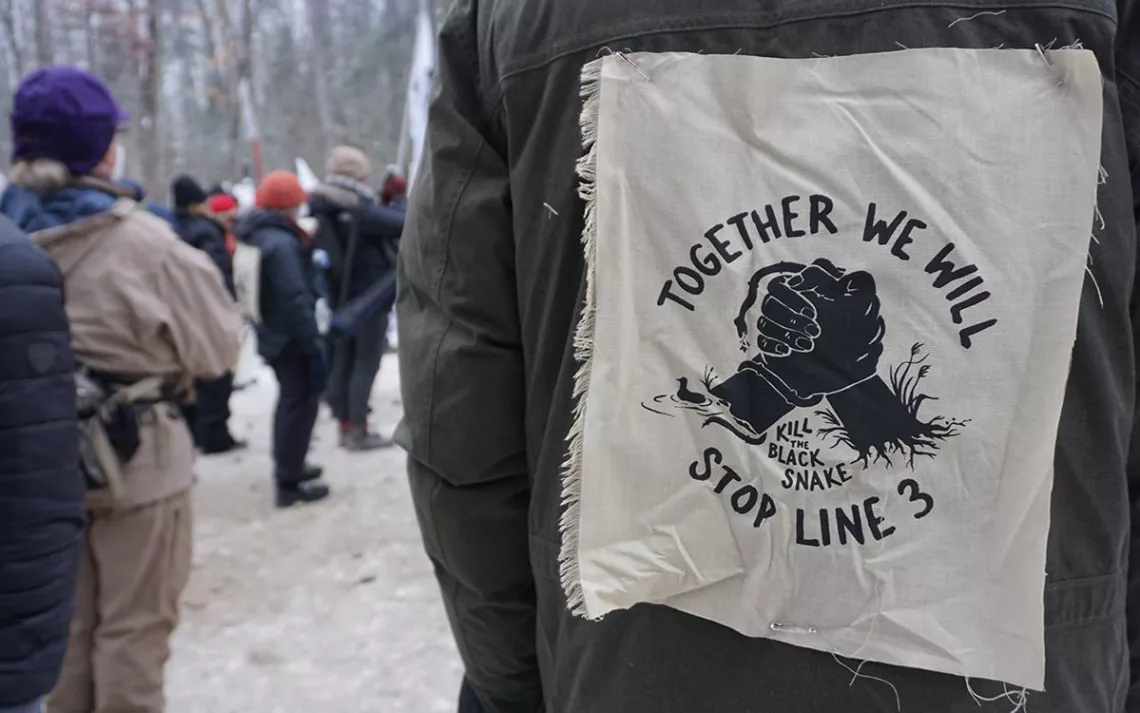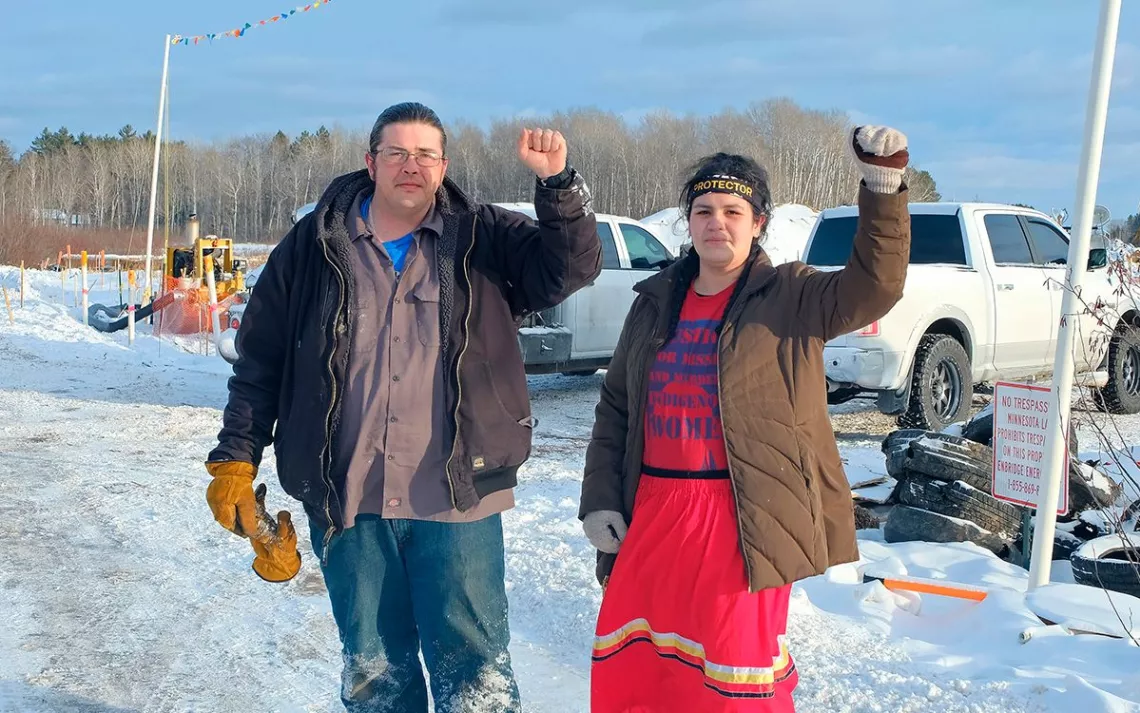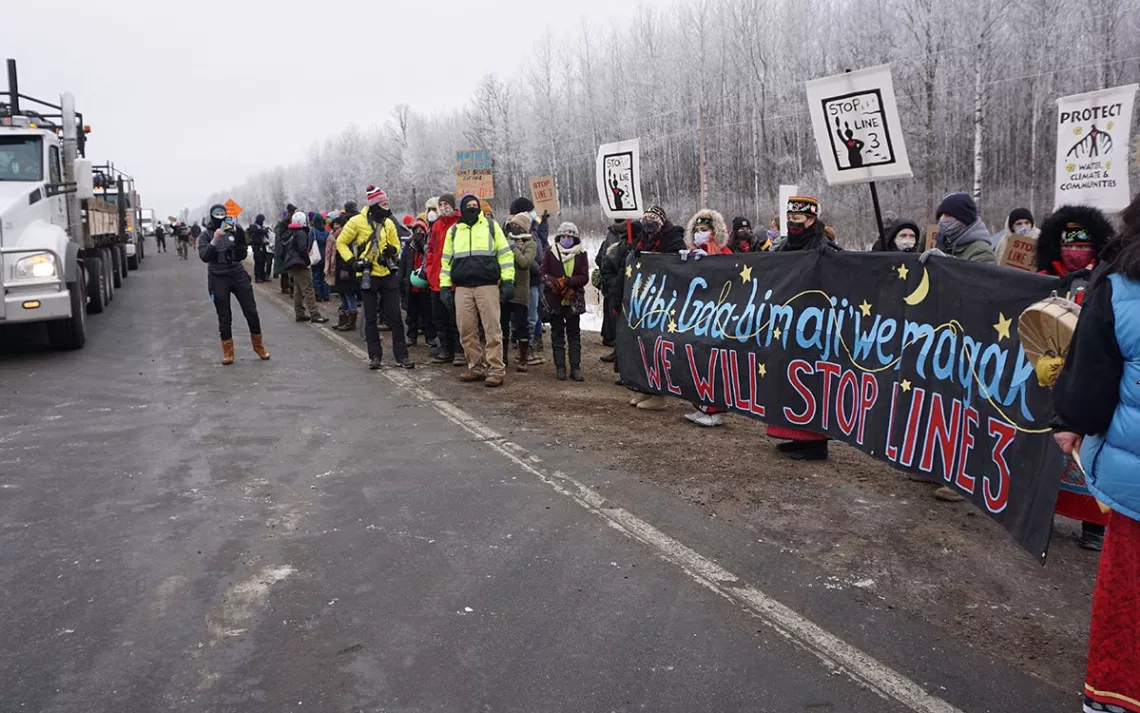As the Line 3 Pipeline Pushes Forward, Water Protectors Push Back
Indigenous activists lead the effort to stop construction

A demonstrator opposing Line 3 wears a patch invoking the fight against the Dakota Access Pipeline. | Photo by Dio Cramer
The water protectors at Camp Migizi, on the Fond du Lac Reservation in Minnesota, wake every morning to the sounds of destruction. Bulldozers crash through the forest, and backhoes dig into the earth. Construction crews are building a $2.9 billion pipeline that would transport 760,000 barrels of crude oil from the Canadian tar sands through northern Minnesota every day. The water protectors are there to stop it.
Construction on the Line 3 pipeline began in December, and Indigenous-led resistance camps sprang up in response. “We literally started with a bell tent and willpower,” Camp Migizi cofounder Taysha Martineau, a member of the Fond du Lac Band of Lake Superior Chippewa, said during a Facebook livestream on February 17. The camp has since grown into a whole collection of tents insulated with bales of straw, separated from one another by snowbanks and stockpiled firewood. The water protectors—activists and organizers leading the fight against Line 3 at Camp Migizi and other camps like it—are braving the cold, and the pandemic, because they see no alternative.
“There’s not an amount of money in the world that would replace what we’re going to lose if we allow them to build that pipeline,” Martineau said over the rumble of construction.
If completed, the 337-mile stretch that runs through Minnesota will cross more than 200 bodies of water, including the Mississippi River—twice—along a route that traverses the Lake Superior and Mississippi watersheds. Line 3 is almost as big as the Keystone XL tar sands pipeline canceled by President Biden on his first day in office, and the #StopLine3 movement is calling on Biden to revoke the federal permits for Line 3 as well.
The Line 3 route also crosses Anishinaabe treaty lands, where the federal government guarantees tribal members the right to hunt, fish, and gather wild rice. According to Anishinaabe teachings, their ancestors came to Minnesota in search of “the land where food grows on water.” That food, wild rice—manoomin—is an Anishinaabe staple that only grows in unpolluted water. It’s difficult to restore after the water is disturbed.
Two Native nations, the Red Lake Band of Chippewa and the White Earth Band of Ojibwe, argue that the federal approval of Line 3 violates their treaty-protected rights. Construction of the pipeline is disrupting ecosystems on which the Anishinaabe people rely, and they fear that an oil spill could be disastrous. Hundreds of pipeline oil spills take place in the US every year, and tar sands oil is harder to clean up than conventional crude oil.

Taysha Martineau and activist Jason Goward at Camp Migizi | Photo by Mary Annette Pember/AP
An Existential Threat
The new Line 3 pipeline is billed as a replacement for an existing pipeline owned by Canadian energy transportation company Enbridge. The original pipeline was built in the 1960s and was responsible for one of the biggest inland oil spills in US history—the 1.7-million-gallon spill near Grand Rapids, Minnesota, in 1991. It has deteriorated so badly that it now operates at reduced capacity as a precaution against future spills.
The replacement pipeline would transport a greater volume of oil than its predecessor and follow a partly new route to avoid crossing the Leech Lake Reservation. Unlike Leech Lake, Fond du Lac leaders agreed in 2018 to allow 13 miles of pipeline to cross the reservation along the original Line 3 route, a decision that angered many band members. Water protectors want the old Line 3 decommissioned and the new Line 3 canceled, calling the new pipeline an expansion, not a replacement.
The new pipeline would lead to emissions equaling those of 50 new coal-fired power plants, according to the state’s environmental impact statement (EIS), which was completed by the Minnesota Department of Commerce in 2019. The EIS also found that the social cost of carbon from the new construction—an economic measure of its climate harm—would amount to at least $287 billion in damages over 30 years.
The state’s Public Utilities Commission (PUC) rejected some of the findings of the EIS in its order granting the final state permit last May. In a footnote, it cited a lack of scientific consensus on the effects of carbon emissions. And it claimed that the pipeline can’t significantly increase carbon emissions since it will transport oil that would be consumed even if the line were not built. But new fossil fuel infrastructure has been found to lock in carbon emissions and increase dependence on fossil fuels over a longer period of time.
Native communities would be especially vulnerable to spills, the EIS found. Oil spills could contaminate their water and endanger their health, their spiritual and religious needs, and their ability to hunt, fish, farm, and gather, including to harvest wild rice. The EIS also warned that the influx of workers on tribal lands during construction could lead to increased sex trafficking or sexual abuse (a finding that water protectors pointed to after two pipeline workers were arrested in mid-February in connection to human trafficking). By granting the permit, the PUC deemed these risks acceptable. The commission disregarded treaty concerns entirely, on the grounds that treaties are federal jurisdiction.
Water protectors believe that the dangers are twofold. They’re worried about the threats that the pipeline poses locally, including the spread of COVID-19 by out-of-state workers and about the carbon emissions that the pipeline would cause. They view Line 3 as the dying gasp of the oil industry—a last-ditch effort to build fossil fuel infrastructure before oil becomes uneconomical and new pipelines become as unrealistic to build as new coal plants.
For Debra Topping, a grandmother—nookomis—and a member of the Fond du Lac Band, the harm is already underway. As a cofounder of the RISE Coalition (Resilient Indigenous Sisters Engaging With Our Allies), Topping sees it as her mission to protect the reservation’s food and water for the next seven generations. Several weeks ago, she watched a construction worker chop down trees traditionally used as medicine, mashkiki.
Topping uses mashkiki to guard against COVID-19 and to treat her husband’s cancer. It angered and pained her to see the worker killing the trees with no regard to the customs involved in gathering them. Before she could try to salvage some of the fallen trees, the crew had ground them into wood chips, ruining them.
“When we gather this mashkiki, it's a mutual respect, where I'm talking directly to the spirit of that medicine,” Topping says. “And I'm asking it, requesting if I can utilize you, if you would be willing to sacrifice yourself so I can live. That man who was doing that didn't have that respect—he doesn't even care that there should be that respect, because it's not his relative. He doesn't see it as a relative; he sees it as a resource. And that's the part that hurts my heart, is that there is no respect.”
Delaying Construction
Native nations, grassroots groups, the Sierra Club, and the Minnesota Department of Commerce believe that the PUC disregarded serious tribal and environmental concerns when it approved Line 3. They are suing at the state level over the permits it granted. The Department of Commerce found that Enbridge did not demonstrate sufficient demand for tar sands oil and is arguing that the PUC made the wrong decision by granting the permits anyway. Its lawsuit is an unusual move, in which the state is essentially suing itself.
Many of the groups behind the state lawsuits are also suing the federal government over a water-crossing permit issued by the Army Corps of Engineers in the final months of Trump’s presidency. They’re arguing that the Trump administration failed to scrutinize the pipeline’s impacts and are calling for a federal environmental impact study to be conducted. And they are demanding that the permit be revoked pending the results of that EIS, which they are sure would demonstrate that the risks far outweigh the benefits.
In early February, the coalition’s requests for a stay in construction pending the results of the lawsuits were denied. If Enbridge completes the pipeline before the cases go to court, little else can be done. So organizers are trying to delay the pipeline long enough for the cases to be heard. To date, more than 100 activists have been arrested for participating in protests to slow construction.
One of these activists is Mary Breen, a non-Native mother of three from Minneapolis who got involved in the fight against Line 3 after her daughter encouraged her to attend the PUC evidentiary hearings in November 2017. A newcomer to PUC meetings, she was disturbed to discover that Enbridge was busing people in to fill the seats at the meetings. Those opposing the pipeline were forced to arrive as early as four in the morning and stand in line for hours just to get a seat.
Breen listened to two weeks of expert testimony and attended one of the many public comment meetings held throughout the state. She felt sure that the PUC would listen to the experts and the residents, and deny the permit. But the commission approved it unanimously in June 2018.
Breen began organizing with MN 350 and starting conversations about Line 3 with others in her community. Her goal has been to create entry points to the movement against the pipeline. “Wherever you are, how can you level up?” she says. “Because that’s what’s necessary right now.”
Since construction started, Breen has been inviting others to caravan two and a half hours north—in separate cars—from Minneapolis to the resistance camps along the pipeline route. She spends most of her time at the camps listening while others speak.
Breen says that once people see what’s happening along the pipeline route, the crisis is hard for them to ignore. “For me, the question was, what am I willing to risk for my daughters’ future? As a mother, there’s nothing I wouldn’t risk.”
Liam DelMain, a non-Native activist who has spent much of the past few months at the resistance camps, was also arrested while protesting the pipeline. In December, DelMain (who uses they/them pronouns) blocked construction on Line 3 for 11 days by living in an aspen tree along the pipeline route.
For those 11 days, as they sat 50 or 60 feet off the ground, construction proceeded all around them. It was an isolating experience. Daily updates and shouted words of encouragement from other protesters across the property line motivated them to stay in the tree until the sheriff finally came up in a cherry picker to extract them.
“I was surrounded by other aspens and white oaks and spruce trees and red pines, and there were critters and bushes and birds,” DelMain says. “Within the course of five or six days, everything around me had been reduced to rubble. All the trees were gone. The earth had been stripped, and it was literally just brown and flat all around me.”
For DelMain, life at the resistance camps brings a range of emotions, from excitement and love to grief and rage. They say the people fighting the pipeline are united by their desire for systemic change, starting with an end to Line 3. In a world of face masks, hand sanitizer, and social distancing, and in spite of the bitter cold, Native and non-Native activists are putting their bodies on the line to stop the pipeline—while also layering up in donated winter gear to share stories and big pots of soup around the fire.
“Being on the front lines, seeing all the destruction, is not easy. It can really suck. And it can also be really joyful being with people who know what the stakes are, and know what they’re willing to risk and what they’re willing to do to fight for what’s right,” DelMain says.

Water protectors gather near the Line 3 Mississippi River crossing north of Palisade, Minnesota. | Photo by Dio Cramer
The Fight Endures
As long as construction goes on, so too will the protests. The resistance camps are growing as the fight ramps up, and the arrests continue. In late January, hundreds of prominent figures, including 35 state lawmakers, published an open letter in the Star Tribune asking Minnesota governor Tim Walz and other state legislators to oppose Line 3, arguing that “[t]he facts are not in Enbridge’s favor, and the time for climate action is now.” The #StopLine3 movement has amassed more than 300,000 signatures on a petition urging Biden to revoke the pipeline’s federal water-crossing permit.
The Minnesota Indian Affairs Council sent a letter to Walz on February 24 asking that he issue a temporary stay in construction on Line 3. The 11-tribe council voted to send the letter by a margin of 5–0, with six tribes abstaining from the vote. The Fond du Lac and Leech Lake Bands, whose agreement with Enbridge bars them from opposing the pipeline, both abstained.
On March 3, the 30th anniversary of the 1991 Line 3 spill, demonstrators gathered near the Mississippi tributary where the spill took place. Dozens of participants were cited by police for blocking traffic during the protest.
Simultaneously, the water protectors are targeting the money behind the pipeline. In early February, Native leaders—including the RISE Coalition—launched #DefundLine3, a new campaign pushing 18 banks to rescind $2.2 million in loans to Enbridge. RISE opened a new resistance camp on February 20.
For Topping, the nookomis who cofounded RISE, preventing Line 3 is about preserving a way of life. She describes herself as a hunter, fisher, and gatherer. She and her husband of nearly 40 years gather hundreds of pounds of wild rice—traditionally the first food given to babies—to share with their community and at ceremonies and funerals each year. They’ve taught their three daughters how to hunt and fish and gather wild rice and medicines, and now they’re teaching their grandchildren.
“We don't get our meat from Walmart,” she says. “We get our food and our meat from nature.”
Topping describes the communal style of living at the camps and the water protectors’ focus on safeguarding the land as “the way it’s supposed to be.” She hopes to return soon to relying on nature—to preparing for maple syrup season, spearing season, berry season, birch bark season, and manoomin season. But for now, she is focused on defending her future generations, because she fears no one else will.
“This is my day job, my night job, my weekend job,” she says. “I feel like I'm kind of fanatical about this. I can't even carry on a normal conversation with anybody, because it all turns around to where do you stand in protecting the food and water that you drink?”
 The Magazine of The Sierra Club
The Magazine of The Sierra Club



